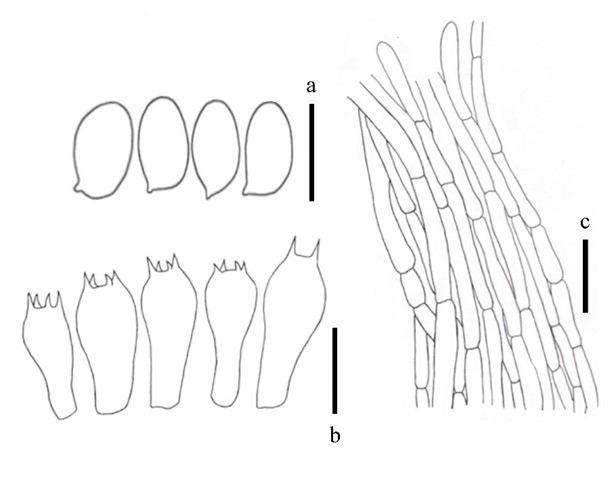Fungalpedia – Note 105 Agaricus
Agaricus L.
Citation when using this entry: Bera et al., in prep – Fungalpedia, Basidiomycota, genera, and terminology. Mycosphere.
Index Fungorum, Facesoffungi, MycoBank, GenBank, Figs 1, 2
Agaricus was introduced in 1753 and belongs to Agaricaceae, Agaricales, Agaricomycetes (He et al. 2019). The genus includes over 500 species worldwide, with Agaricus campestris L. as the type species. Agaricus is a saprobic genus found in forests and grasslands. The genus is characterized by white to pink free lamellae when young, brown to dark brown when mature, and with an annulated stipe. There are approximately 6,000 records of Agaricus in Index Fungorum (www.indexfungorum.org; accessed in May 2023). The genus is divided into sections based on molecular phylogenetic and morphological characteristics. The taxonomy system of Agaricus is complex. The schäffer reaction, alkali reaction, discoloration of sporocarp when bruised, and odor are used to divide the taxa into sections; however, environmental effects and intraspecific variabiliy makes it difficult to distinguish between close species. Therefore, molecular analysis has been used as a tool to identify Agaricus to the species level. Mitchell (1999) established a molecular phylogeny of Agaricus based on the ITS region + 28s rRNA gene. To date, molecular multigenes have been used for classification. Zhao et al. (2016) used multigenes (ITS, LSU, and tef1) and divergence time to divide Agaricus into five subgenera and 20 sections. Later, the genus was reported to have six subgenera and 23 sections (Chen et al. 2017; Parra et al. 2018). He et al. (2018) introduced a new section. The genus now contains seven subgenera and 28 sections (Ortiz-Santana et al. 2021; Bashir et al., 2023)
Type species: Agaricus campestris L
Other accepted species: see Species Fungorum – search Agaricus for names.
Figure 1 – Macrocharacters of Agaricus subtilipes (MFLU 120847, holotype), Thailand (Thongklang et al. 2016) a Basidiomes. b Light brown dot-like to triangular scales on pileus, c Well-developed floccose-squamulose ornamentation of the annulus. Scale bars: a, b = 5 cm, c = 2 cm.
Figure 2 – Microcharacters of Agaricus subtilipes (MFLU 120847, holotype) from Thailand (Thongklang et al. 2016). a Basidiospores. b Basidia, c Pileipellis. Scale bars: a = 5 µm, b, c = 10 µm.
References
Bashir H, Fatima N, Izhar A, Niazi AR et al. 2023 – Agaricus radiatosquamulosus sp. nov. and A. subg. Spissicaules from Pakistan. Phytotaxa, 579, 231–242.
Chen J, Callac P, Parra LA, Karunarathna SC et al. 2017 – Study in Agaricus subgenus Minores and allied clades reveals a new American subgenus and contrasting phylogenetic patterns in Europe and greater Mekong Subregion. Persoonia 38, 170–196.
He MQ, Chuankid B, Hyde KD, Cheewangkoon R, Zhao RL. 2018 – A new section and species of Agaricus subgenus Pseudochitonia from Thailand. MycoKeys 40, 53–67.
Mitchell AD, Bresinsky A. 1999 – Phylogenetic relationships of Agaricus species based on ITS-2 and 28S ribosomal DNA sequences. Mycologia 91, 811–819.
Ortiz-Santana B, Chen J, Parra LA, Angelini C et al. 2021 – The genus Agaricus in the Caribbean II. Refined phylogeny of Agaricus subg. Spissicaules with description of two new sections and eight new species. Mycological Progress 20, 381–411.
Parra LA, Angelini C, Ortiz-Santana B, Mata G et al. 2018 – The genus Agaricus in the caribbean. Nine new taxa mostly based on collections from the Dominican republic. Phytotaxa, 345, 219–271.
Thongklang N, Chen J, Bandara AR, Hyde KD et al. 2016 – Studies on Agaricus subtilipes, a new cultivatable species from Thailand, incidentally reveal the presence of Agaricus subrufescens in Africa. Mycoscience, 57.
Zhao RL, Zhou JL, Chen J, Margaritescu S et al. 2016 – Towards standardizing taxonomic ranks using divergence times – a case study for reconstruction of the Agaricus taxonomic system. Fungal Diversity, 78, 239–292.
Entry by
Thongklang N., Center of Excellence in Fungal Research, Mae Fah Luang University, Chiang Rai, 57100, Thailand, and School of Science, Mae Fah Luang University, Chiang Rai 57100, Thailand
(Edited by Kevin D. Hyde)
Published online 20 September 2023

